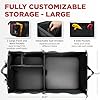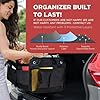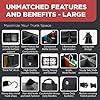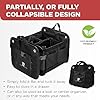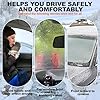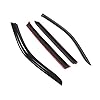Table of Contents
Car insurance is key for car owners. It acts as a financial safety net against accidents, theft, and other vehicle issues. It’s important to have a guide for buying car insurance. This guide will help you find the best insurance and compare quotes.
Accidents can lead to unexpected repair costs without insurance. Almost every state requires some liability coverage. This guide will help you understand the different coverages and make the right choice.
Shopping around is crucial for the best car insurance rates. Comparing quotes from different insurers can save you money. Look for discounts for military, federal employees, homeowners, and students to save more.
Key Takeaways
- Car insurance is a crucial component of responsible vehicle ownership, protecting car owners from unexpected costs.
- Comparing car insurance quotes is vital to ensure you get the best deal on car insurance rates.
- Understanding the different types of coverage, including liability coverage, collision coverage, and comprehensive coverage, is essential when buying car insurance.
- Shopping around and exploring discounts can help you save on car insurance premiums.
- Staying informed about industry changes is crucial for making informed decisions when buying car insurance.
- Following a car insurance buying guide can help you make informed decisions and find the best car insurance for your needs.
Understanding the Basics of Auto Insurance Coverage
When looking for the right car insurance, knowing the different coverage options is key. A good guide will help you understand these options. Auto insurance usually covers property, liability, and medical costs. Laws in each state set the minimum insurance needed for accidents.
In the U.S., most auto insurance policies last from six months to a year. Premium costs can change based on the driver, car type, and credit score. For example, teen drivers and expensive cars can make premiums higher.
- Liability Coverage: pays for damages and injuries caused to others in an accident
- Comprehensive Coverage: pays for damages to the car that are not caused by an accident, such as theft or natural disasters
- Collision Coverage: pays for damage to the car caused by a collision
- Personal Injury Protection (PIP): provides reimbursement for medical expenses due to injuries in the insured vehicle
- Uninsured Motorist Coverage: reimburses when an uninsured driver causes an accident
Knowing these coverage options helps you choose the right car insurance. It lets you create a personalized guide for your needs.
| Type of Coverage | Description |
|---|---|
| Liability Coverage | Pays for damages and injuries caused to others in an accident |
| Comprehensive Coverage | Pays for damages to the car that are not caused by an accident, such as theft or natural disasters |
| Collision Coverage | Pays for damage to the car caused by a collision |
The Complete Car Insurance Buying Guide
When you’re looking to buy car insurance, finding the best car insurance quotes is key. It’s important to compare rates from various insurance providers, like geico. This way, you can get the most affordable and complete coverage for your needs.
Here are some factors that can affect your car insurance rates:
- Age and driving experience
- Type of vehicle and its value
- Driving history and record
- Location and zip code
To compare rates, getting multiple car insurance quotes is a smart move. You can check insurance company websites, like geico, or use online tools to compare quotes.
Don’t forget to look at the insurance company’s reputation, customer service, and financial stability. By researching and comparing, you can find the best car insurance that fits your budget and needs.
| Insurance Company | Quote Comparison Tool | Customer Service |
|---|---|---|
| Geico | Available | 24/7 support |
| State Farm | Available | 24/7 support |
Factors That Affect Your Insurance Rates
When thinking about how much should i spend on car insurance, it’s key to know what affects your rates. The type and age of your car matter a lot. Newer cars with safety features cost less to insure. Older cars or those at high theft risk cost more.
Your driving history and experience also play a big role. Drivers with clean records pay less. Those with accidents on their record pay more. Your credit score also matters, as a good score can lower your rates. When what to know when buying car insurance, these factors are crucial to consider for the best rates.
Other things that can change your rates include where you live, if you’re married, and your age. Drivers in cities often pay more because of higher risks of theft and accidents. Young drivers, especially teens, usually pay more because they’re more likely to have accidents.
| Factor | Impact on Insurance Rates |
|---|---|
| Vehicle Type and Age | Newer cars with advanced safety features tend to have lower insurance rates |
| Driving History and Experience | Drivers with clean records generally pay lower premiums |
| Credit Score | A good credit score can lead to lower premiums |
Understanding these factors helps you make smart choices when buying car insurance. This way, you can find the best rates for your needs.
How to Calculate Your Ideal Coverage Amount
To figure out your ideal coverage amount, think about your vehicle’s value, how you drive, and your financial status. When you’re looking to get a car insurance quote, knowing how these factors affect your coverage is key. An auto insurance buying guide can offer great advice on this.
Recent data shows the average cost of a bodily injury claim in 2023 was $26,501. This shows why having enough coverage is crucial. Some states require a minimum of $15,000 for bodily injury liability. But experts suggest at least $100,000 per person and $300,000 per accident. When figuring out your coverage, consider these points:
- Liability coverage limits: $100,000 per person and $300,000 per accident for bodily injuries, and $100,000 for property damage
- Collision and comprehensive coverage deductibles: ranging from $250 to $1,000
- Medical payments coverage or Personal Injury Protection (PIP) limits: typically ranging from $1,000 to $10,000 per person
By understanding these factors and using an auto insurance buying guide, you can make smart choices when getting a car insurance quote. Don’t forget to think about extra coverage options like rental reimbursement and towing and labor cost coverage. This ensures you have the right protection for your vehicle and finances.
Comparing Top Insurance Providers
Choosing the right car insurance provider is crucial. Consumer reports best car insurance companies name Geico and State Farm as leaders. They offer various coverage options and benefits. In California, the car insurance buying guide california helps drivers make informed choices.
When comparing providers, coverage options are key. Geico offers liability, collision, and comprehensive coverage. State Farm adds benefits like roadside assistance and rental car coverage.
| Provider | Coverage Options | Benefits |
|---|---|---|
| Geico | Liability, Collision, Comprehensive | Roadside assistance, rental car coverage |
| State Farm | Liability, Collision, Comprehensive, Roadside assistance | Rental car coverage, accident forgiveness |
By comparing top providers, drivers can find the best fit for their needs.
Consumer Reports Rankings and Recommendations
Choosing the right car insurance can be tough. Consumer Reports helps by offering rankings and tips. The top 10 best car insurance options are listed to guide you.
Consumer Reports says State Farm car insurance is a top choice, with a yearly cost of $1,147. Geico and Progressive also have good rates. Here’s a look at the costs:
| Insurance Provider | Annual Premium |
|---|---|
| USAA | $817 |
| State Farm | $1,147 |
| Geico | $1,177 |
| Progressive | $1,414 |
| Allstate | $1,570 |
These rankings can help you pick the best car insurance. Think about customer happiness and claims handling too.
State-Specific Requirements and Considerations
Every state has its own rules for car insurance. In California, drivers must have a certain amount of liability insurance. This is covered in a car insurance buying guide california. The guide explains the different coverages and how to pick the best policy.
To get insurance when buying a car, drivers need to know their state’s minimums. These vary, but most require bodily injury and property damage liability insurance. For example, the minimum bodily injury liability per person can be from $15,000 to $50,000.
Some states have special coverage options, like survivors benefits and medical payments. They also offer a combined liability limit. It’s crucial for drivers to know these to get the right coverage.
California Insurance Guidelines
In California, the car insurance buying guide california helps drivers understand the minimums. It also talks about how to choose a policy, including deductibles and premiums.
Minimum Coverage Requirements by State
Minimum coverage requirements differ by state. Most require bodily injury and property damage liability insurance. Drivers should check their state’s specific requirements to ensure they’re covered.
Getting and Comparing Insurance Quotes
When looking for how to get the best car insurance, comparing quotes is key. This can take time, but it’s worth it to find good coverage at a good price. On average, it takes about 4 minutes to compare car insurance quotes, which can save a lot of money.
A guide to buying car insurance should talk about what affects car insurance rates. These include the car’s type, where you live, your driving record, and how much you drive each year. Knowing these can help you make smart choices when comparing quotes.
Some important things to think about when comparing quotes include:
- Understanding state minimum financial responsibility limits
- Importance of additional liability, comprehensive, and collision coverage
- Budget considerations when choosing a deductible
To get accurate quotes, you’ll need to share details about your current insurance, your car, your driver’s license, and any accidents. You can also look for ways to lower your premium, like using car insurance discounts or telematics programs.
By following these tips and thinking about your options, you can find the best car insurance for your needs and budget. Always check the customer service, reputation, and ratings of insurance companies. Also, regularly review your coverage to get the most benefits and discounts.
| Insurance Provider | Coverage Options | Premiums |
|---|---|---|
| Nationwide | Liability, collision, comprehensive | Varies by state and driver |
| Geico | Liability, collision, comprehensive | Varies by state and driver |
Understanding Deductibles and Premiums
When you’re looking at car insurance, it’s key to get the basics right. Deductibles and premiums are crucial. A deductible is what you pay first before your insurance helps. For example, if you have a $500 deductible and your car is damaged for $2,000, you’ll pay $500. Then, your insurance will cover the rest, $1,500.
Choosing the right deductible is important. A higher deductible means lower monthly payments. But, you’ll have to pay more if you need to file a claim. Lower deductibles mean higher monthly costs but might be better if you live in an area with lots of claims. Think about your budget and how you drive to decide.
Here are some things to think about when looking at deductibles and premiums:
- Deductible amounts: They can be from $250 to $2,000 or more, depending on the company and policy.
- Premium calculation: Companies look at your driving history, car type, and where you live to set your premium.
- Cost-saving strategies: Picking a higher deductible, combining policies, or using discounts can lower your costs.
Knowing how deductibles and premiums work helps you choose the right car insurance. You’ll find a policy that’s affordable but still covers you well.
| Deductible Amount | Premium Cost | Out-of-Pocket Expenses |
|---|---|---|
| $250 | Higher | Lower |
| $1,000 | Lower | Higher |
| $2,000 | Lower | Higher |
Common Discounts and How to Qualify
When looking for a car insurance guide, it’s key to know about discounts. A Reddit thread on car insurance might talk about how discounts can lower your rates. Discounts like good student, military, and defensive driving course discounts are common.
Other discounts include multi-car discounts, paid-in-full discounts, and claims-free discounts. Some companies also offer safe driver discounts for those who don’t get into accidents. To get these discounts, you need to meet certain criteria, like having a clean driving record or good grades.
Some notable discounts and their savings are:
- Paperless discount: 5-10% savings
- Loyalty discount: increases with tenure
- Continuous insurance discount: rewards responsible drivers
- Multi-car discount: 5-10% savings
It’s important to check a car insurance guide to learn about discounts and how to qualify. By using these discounts, you can lower your insurance costs and make it more affordable.
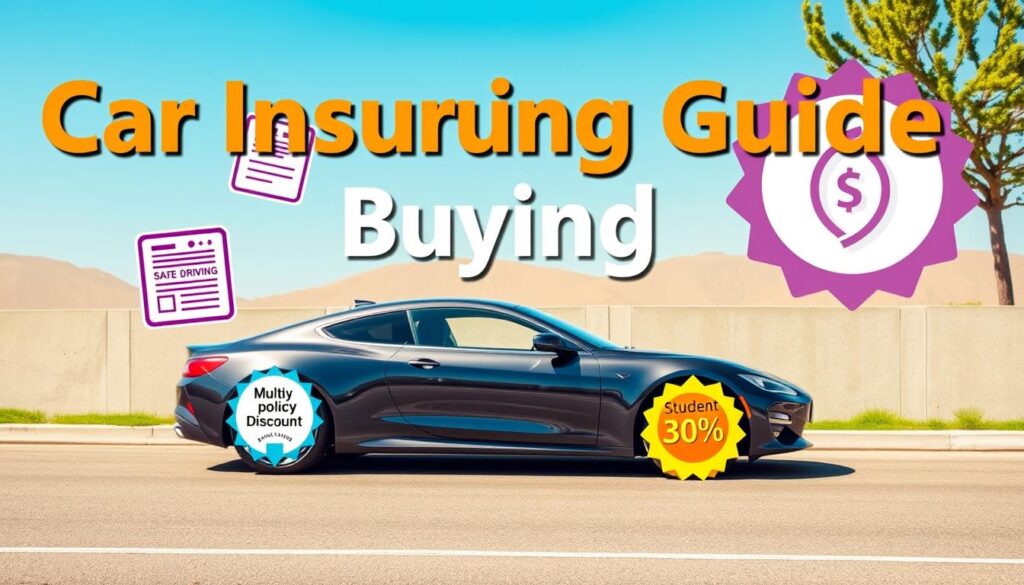
Digital Tools and Resources for Insurance Shopping
Buying car insurance can be easier with the right digital tools. A consumer reports car insurance buying guide offers valuable insights. It helps you understand the process better. Online quote tools, mobile apps, and customer reviews are key resources.
Here are some important digital tools and resources:
- Online quote comparison tools, which allow you to compare rates from different insurance providers
- Mobile apps for insurance management, which enable you to access your policy documents, make payments, and file claims on the go
- Customer review platforms, which provide feedback and ratings from other customers to help you make an informed decision
These tools help you find the best insurance for your needs. Always compare quotes and read reviews to get the best deal. With the right tools, you can make a smart choice and get the insurance you need.
Here is a summary of the key points to consider when using digital tools and resources for insurance shopping:
| Tool/Resource | Description |
|---|---|
| Online Quote Comparison Tools | Compare rates from different insurance providers |
| Mobile Apps for Insurance Management | Access policy documents, make payments, and file claims on the go |
| Customer Review Platforms | Read feedback and ratings from other customers |
By following these tips and using the right digital tools, you can find the best car insurance. Remember, getting insurance when buying a car is crucial. Use a consumer reports car insurance buying guide to make a smart choice.
Red Flags to Watch For When Buying Insurance
When looking for the best car insurance, knowing the red flags is key. A good guide to buying car insurance will teach you how to spot these issues. High-pressure sales are a big concern, as they can lead to hasty choices and missed details.
To get the best car insurance, compare different providers carefully. Look at their coverage, prices, and what others say about them. Watch out for hidden fees that can raise the policy cost a lot. Also, be wary of aggressive marketing, which might mean the company is desperate or shady.
Some other red flags to watch for include:
- Missing or incomplete paperwork
- Excessive wear and tear on the vehicle
- A price significantly lower than the market value
- An overly clean interior contrasting with the car’s overall condition
Knowing these red flags helps you make a smart choice. Take your time to research and compare. Always choose a provider that is clear, transparent, and reputable. If unsure, ask for advice from a trusted expert or check reviews online.
Steps to Switch Insurance Providers
Thinking about switching car insurance can save you money and improve your coverage. Experts say the best time to switch is at your current policy’s renewal date. This avoids cancellation fees and coverage gaps.
When switching, consider timing, required documents, and avoiding gaps in coverage. Make sure the new policy starts on the same day the old one ends. This prevents coverage lapses. Also, keep your proof of insurance handy during the switch. Inform your lender or leasing company if you have an auto loan or lease.
Timing Your Switch
You can switch car insurance at any time. It’s often done when moving, buying a new car, or adding a family member. Many companies offer discounts that can save up to 20% on premiums. It’s worth looking into these when you switch.
Required Documentation
When switching, you’ll need proof of insurance, vehicle registration, and a driver’s license. It’s also key to understand the new policy’s terms. This includes coverage levels, deductibles, and premiums.
Avoiding Coverage Gaps
To avoid gaps in coverage, make sure the new policy starts when the old one ends. Coordinate with both providers for a smooth transition. By following these steps, you can make an informed choice and find the right coverage for you.
| Insurance Provider | Discounts Offered | Coverage Levels |
|---|---|---|
| Geico | Up to 15% off | Liability, collision, comprehensive |
| State Farm | Up to 20% off | Liability, collision, comprehensive, personal injury protection |
Making Your Final Decision
When looking for car insurance, it’s key to think about several things before you decide. A car insurance guide can really help. Experts say to get quotes from at least three companies. You can find useful tips on a car insurance guide reddit forum.
Here are some things to think about:
- Coverage options: Look at policies with the same limits and deductibles to compare prices.
- Premiums: The average yearly cost for full-coverage car insurance in the U.S. is about $2,014.
- Customer service: Check the company’s reputation and read what other customers say.
Also, look at the discounts each company offers. For example, Geico has 16 different discounts. By carefully looking at these points and using a car insurance guide, you can pick the best policy for you.
Conclusion
When looking for car insurance, it’s all about finding the right mix. You want good coverage, a fair price, and great service. Start by checking your state’s minimum insurance laws. Then, think about what you really need and compare prices from different companies.
Cost is key, but don’t forget about the coverage you need. Think about adding extra coverage like comprehensive and collision insurance. Also, look for discounts and adjust your deductibles to save money without sacrificing too much.
This guide is here to help you make a smart choice. Your insurance needs might change, so keep an eye on your policy. Be ready to update it as your life and car situation changes.









